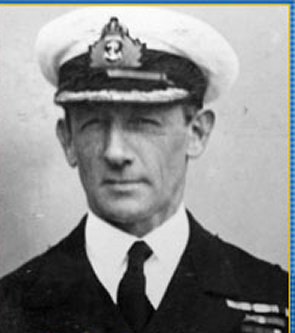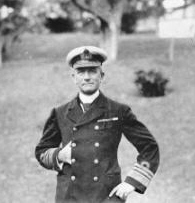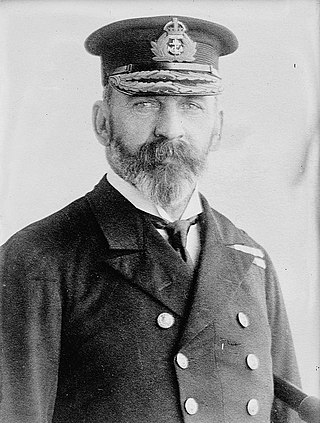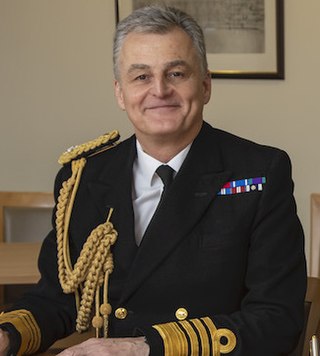
Admiral of the Fleet Peter John Hill-Norton, Baron Hill-Norton, was a senior Royal Navy officer. He fought in the Second World War as gunnery officer in a cruiser operating on the Western Approaches and in the North Sea taking part in the Norwegian Campaign, then in a cruiser taking part in the Arctic convoys and finally in a battleship operating in the Eastern Fleet. After the War he commanded a destroyer and then an aircraft carrier. He served as First Sea Lord and Chief of the Naval Staff and then Chief of the Defence Staff in early 1970s. In the latter role he gave the final commitment to Project Chevaline, the Polaris missile improvement programme. He went on to be Chairman of the NATO Military Committee.
Admiral Sir Ernest Frederick Augustus Gaunt, was an Australian-born Royal Navy officer who went on to be Commander-in-Chief, Western Approaches.

Admiral Sir John Cunningham Kirkwood "Jock" Slater, is a retired Royal Navy officer. He commanded a minesweeper, a frigate and then a destroyer before taking over the aircraft carrier HMS Illustrious and then achieving higher command in the Navy. He served as First Sea Lord and Chief of the Naval Staff from 1995 to 1998: in that capacity he played a key role in the 1998 Strategic Defence Review carried out by the Labour Government that had come to power a year earlier.

Admiral Sir Nigel Richard Essenhigh is a former Royal Navy officer who served as First Sea Lord and Chief of the Naval Staff from 2001 to 2002. He served as a navigating officer before commanding the Type 42 destroyer HMS Nottingham and then the Type 42 destroyer HMS Exeter during the Gulf War. As First Sea Lord he entered into a contract to acquire up to 150 Joint Strike Fighter aircraft for the UK's two new aircraft carriers. In retirement he worked for Northrop Grumman and became a non-executive director of Babcock International. He remains a Deputy Lieutenant of Devon.

Admiral of the Fleet John David Elliott Fieldhouse, Baron Fieldhouse, was a Royal Navy officer. He commanded five submarines and a frigate before achieving higher command from the 1970s. Following the invasion of the Falkland Islands by Argentine forces in April 1982, Fieldhouse was appointed Commander of the Task Force given responsibility for "Operation Corporate", the mission to recover the Falkland Islands. The campaign ended in the surrender of Argentine forces in June 1982. He became First Sea Lord and Chief of Naval Staff in December that year and, in that role, persuaded the British Government to fund the replacement of ships lost in the Falklands War. He went on to be Chief of the Defence Staff from 1985 until his retirement in 1988.

Admiral of the Fleet Terence Thornton Lewin, Baron Lewin, was a Royal Navy officer. He served in the Second World War and then commanded a destroyer, the Royal yacht, two frigates and an aircraft carrier before achieving higher command. He was First Sea Lord and Chief of the Naval Staff in the late 1970s and in that role he worked hard to secure a decent wage for servicemen and helped win them a 32% pay rise. He went on to be Chief of the Defence Staff during the Falklands War, serving as chief war planner and as Prime Minister Margaret Thatcher's chief advisor during the war. He was also the first Chief of Defence Staff to act as head of the Armed Forces rather than just Chairman of the Chiefs of Staff Committee.
Admiral Sir David John Hallifax, was a senior Royal Navy officer who served as Constable and Governor of Windsor Castle from 1988 until 1992.

Admiral of the Fleet Sir Henry Conyers Leach, was a Royal Navy officer who, as First Sea Lord and Chief of the Naval Staff during the early 1980s, was instrumental in convincing the British prime minister, Margaret Thatcher, that retaking the Falkland Islands from Argentina was feasible. On account of the determination he showed in the matter, journalist and political commentator Andrew Marr described him as Thatcher's "knight in shining gold braid".

Admiral Sir John David Luce, was a Royal Navy officer. He fought in the Second World War as a submarine commander before taking part in the Dieppe Raid and becoming Chief Staff Officer to the Naval Forces for the Normandy landings. He also commanded a cruiser during the Korean War. He served as First Sea Lord and Chief of the Naval Staff in the mid-1960s and in that role resigned from the Royal Navy along with Navy Minister Christopher Mayhew in March 1966 in protest over the decision by the Labour Secretary of State for Defence, Denis Healey, to cancel the CVA-01 aircraft carrier programme.
Stubbington House School was founded in 1841 as a boys' preparatory school, originally located in the Hampshire village of Stubbington, around 1 mile (1.6 km) from the Solent. Stubbington House School was known by the sobriquet "the cradle of the Navy". The school was relocated to Ascot in 1962, merging with Earleywood School, and it closed in 1997.

Admiral Sir Gerald Louis Charles Dickens was a senior Royal Navy officer and the grandson of Victorian novelist Charles Dickens.

Admiral Sir George Edwin Patey, was a senior officer in the Royal Navy.

Admiral Sir Arthur William Moore, was a Royal Navy officer who became both Commander-in-Chief, China and Commander-in-Chief, Portsmouth.
Admiral Sir Rudolf Miles Burmester, was a Royal Navy officer who went on to be Commander-in-Chief, Africa Station.

Vice-Admiral Arthur Edward Frederick Bedford, CB, CSI was a Royal Navy officer. He served in HMS Kent at the Battle of the Falkland Islands of 1914 and rose to command the Royal Indian Navy from 1934 to 1937, when he retired. A year later he rejoined the colours and served until the end of the Second World War.

Admiral Sir Philip Andrew Jones, is a retired senior Royal Navy officer. After service in the South Atlantic in 1982 during the Falklands War, he commanded the frigates HMS Beaver and HMS Coventry. He went on to be Flag Officer, Scotland, Northern England and Northern Ireland, Commander United Kingdom Maritime Forces and Assistant Chief of the Naval Staff before being appointed Fleet Commander and Deputy Chief of the Naval Staff. Jones served as First Sea Lord from April 2016 to June 2019.
Rear Admiral Hector George Boyes, was an officer of the Royal Navy.

Commodore James Dalgleish (1891–1964) served as the Chief of the Seaward Defence Force, which later became the South African Navy.
Rear-Admiral Henry Montagu Doughty, was an officer of the Royal Navy during the First World War.

Admiral Sir Timothy Peter Fraser, is a retired senior Royal Navy officer who served as Vice-Chief of the Defence Staff from May 2019 to August 2022.














